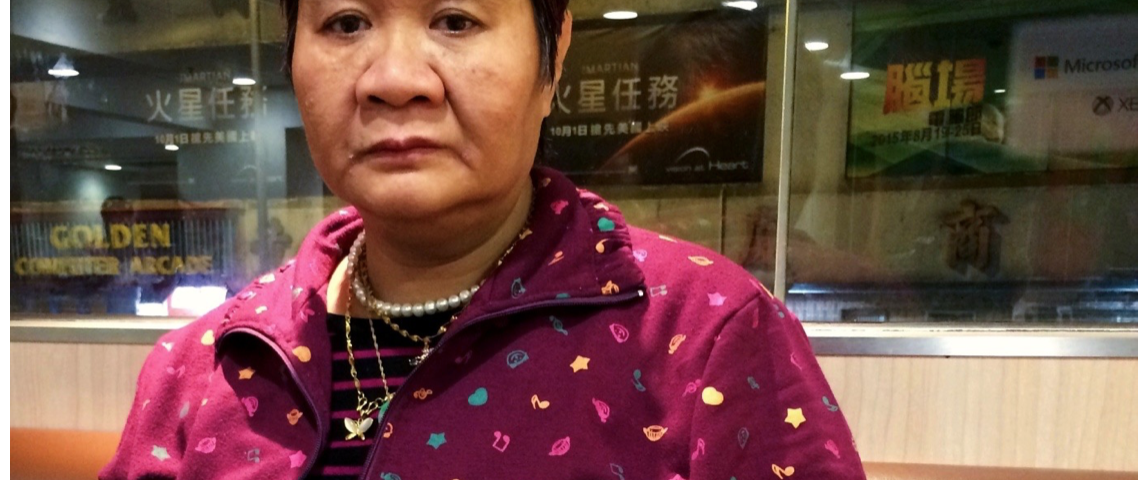It is 10pm on a Friday night in Hong Kong, and the 24 hours McDonald’s in the city’s poorest district, Sham Shui Po, has all the offensive lighting, teenage couples and half-finished sundaes that one would expect. But it also has a seating area, tucked away at the very back of the second floor, occupied by people who are clearly not here for a Happy Meal.
A middle-aged man with a collection of small plastic bags lies stretched out on a booth, while a slightly younger one, who was too late to find better seating, tries to fall asleep resting his head on a table. A fifty-something-year-old with overgrown facial hair plays a seemingly endless game of solitaire, ignoring a petite lady who is laughing frantically and stomping her feet right in front of him. In another corner, a sad-eyed woman in her fifties is battling to stay awake.
“McRefugees” is how a Washington Post article referred to the growing phenomenon in Hong Kong of people who turn to the fast-food chain’s round-the-clock outlets for overnight shelter. The passing away of one of these shelter-seekers in a McDonald’s on October 2nd sparked awareness about the city’s poor and homeless. But many “McRefugees” belong simultaneously to yet another marginalized group that remains largely unseen — the mentally ill.
The name of the sad-eyed lady in the corner is Man Zheng Chui, and what brings her to McDonald’s for nights on end is not homelessness, but insomnia.
“When I can sleep, I go home,” she says, in broken, unclearly articulated sentences that are difficult for the translator to understand despite the louder-than-average volume of her voice. “Home” is an apartment in a public housing building in Sham Shui Po, which she describes as “comfortable”.
She lives alone. Her husband died more than two decades ago, and she has a son who she hasn’t seen in years. How many years? “Too long, I can’t remember,” she confesses. She also can’t recall when she last saw her mother and two sisters, who live in the New Territories. They call her sometimes, but, like her son, they are all “too busy” to see her in person, she explains.
Mrs. Man has been lucky enough to tap into some of the governmental and non-governmental support mechanisms available for persons with mental disabilities.
Apart from public housing, she receives between HK$3,000-HK$4,000 from the Comprehensive Social Security Assistance Scheme (CSSA), and another $300 to $400 -plus free lunch- from Po Leung Kuk, a long-standing social service organization where she is being trained as a cleaner. Both sources of income add up to get her just over the government’s official poverty line, which is drawn at HK$3,500 a month for a one-person household.
But not all the mentally ill have a safety net to fall back on. According to estimates by the Society for Community Organization (SoCO), 200,000 people with mental disabilities are waiting for medical assistance and community support.
Tim Pang, a SoCO social worker in his 40s, explains that one of the main problems is lack of manpower for personalized care and follow-up programmes for the mentally ill.
The recent knife attacks by a discharged psychiatric patient against passers by on Des Voeux Road on October 18th, and the arrest of another man suspected of stabbing his mother to death have vividly exposed these shortcomings. According to, a report in the South China Morning Post, the scarcity of local psychiatrists is expected to persist for another twenty years.
Another shortage exists in the allocation of government housing for people with mental illness.
Pang explains that the usual procedure is for psychiatric patients to be sent, after hospitalization, to “halfway homes” where they are cared for for two to three years. If their families are not capable of taking them back into their homes after this period, they apply to public housing through the Compassionate Rehousing scheme.
“But nowadays, with the shortage of provision, it is quite unlikely for them to get public housing. Most of them will have to rent a place on their own, or go to public hostels,” explains Pang. Or to McDonald’s.
Many end up as one of the 210,000 people who live in inadequate housing conditions -caged homes, cocklofts, subdivided flats- or into the group of the homeless, which official government figures estimate at 700 and a City University study at twice the figure. A recent investigation by the University of Hong Kong (HKU) and the Prince of Wales Hospital, found that 56% of their surveyed sample of homeless people suffered from mental problems.
But insufficiencies in health care and poverty alleviation for the mentally ill are only part of the story.
“They are facing quite a serious stigmatization,” says Pang, suggesting that social attitudes are the other half of the problem. For example, “There are many vocational rehabilitation centres for them, but not enough compassionate employers willing to hire them.”
When Mrs. Man is asked when she will complete her training as a cleaner and look for a job, she replies that she will not. Why not? “I’m not good enough,” she said. “I cannot work outside the centre.” The reason she cannot work well, she says, is her lack of sleep, which even the pills that her doctor gives her can’t cure. By now, she has received decades of training.
Criminal incidents like those of October 18th increase their stigmatization, says Pang, and makes society fear them instead of accept and support them. Sensing that they are not accepted, “they tend to hide away from the public, which makes them even more isolated and helpless.”
Perhaps the proximity to others as lonesome as her, and the sense that her isolation is collective, are part of the reason why Mrs. Man would rather spend her nights at McDonald’s than at home.



